
Science in hinduism-Embryology in Garbhopanishad and Charaka samhita
Why you must have this Vedic knowledge of embryology?
In traditional Indian joint family, daughters-in-law are often blamed, if she continuously gives birth to a female child and is unable to beget a male child. This belief exists despite of the fact that our religious scripture says differently which also means that modern Hindus do not have any knowledge of their sacred scriptures. Social evil of dowry and child marriages that arose as the result of foreign invasion does not allow modern Hindus to accept the fundamental scientific truth that mother has no role to play in determining the sex of the baby. Continuous incidents of dowry deaths, devdasi system, sati system and girls infanticide has downgraded the male sex ratio to such a level that India faces the acute shortage of 20 million girls.

Modern corrupt Godmens, seers, sages, swami, who have nil knowledge of our vast scriptures, are only interested in grabbing lands worth thousands of crores instead of stopping these evil social practices. Due to some vested interests, Modern Brahmins don’t show active interest in spreading the scientific outlook of ancient Vedic knowledge despite of the fact that the Vedic science encourages us to dispel the mode of ignorance and follow the path of truth & righteousness. As I continue to enlighten myself on the outstanding Vedic literatures, I am writing this post to acknowledge the scientific concept of embryology in Vedic science. In this article, I am posting some details on embryology from ayurvedic scriptures like Garbhopanishad and charaka samhita. Details from spiritual scriptures like bhagavat purana would be discussed in a separate post.
Science of embryology in Vedic scriptures
Science of embryo development from the initial stages of ovum fertilization to fetus stage is called embryology. One of the ancient Upanishads, Garbhopanishad, has precise detailed information on embryology, matching very closely with modern scientific embryology, excluding some details still unknown to modern science.
In Vedic scriptures, it is clearly mentioned that the gender of the unborn child is dependent on the seed (male aspect) and not on prakriti(female aspect). Decades of modern scientific research in laboratories across the world has finally proved this Vedic truth.
Spiritual explanation to embryology
In popular texts like Brahma-samhita and srimad bhagvatam, it is declared that the Supreme Soul not only enters each and every universe created by him, but also enters every single atom of each universe. The same concept is the basis to embryo development where the part of the supreme soul(Atman) enters the embryo of the mother in the dormant stage of pregnancy
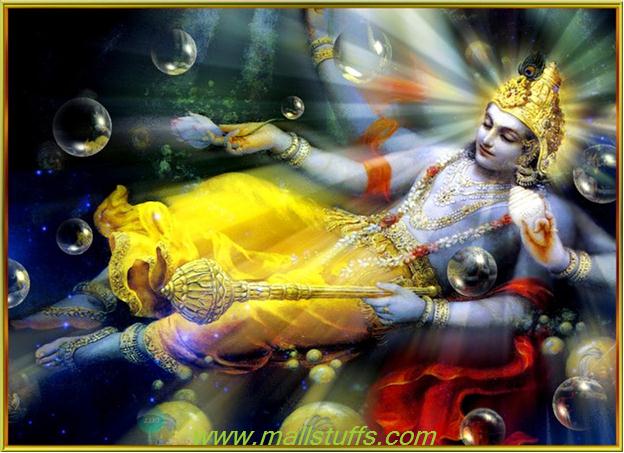
“Under the supervision of the Supreme Lord and according to the result of his work the living entity, the soul, is made to enter into the womb of a women through the particle of the men semen to assume a particular type of body.”-srimad bhagvatam
Short introduction to embryology from Indian religious scriptures
According to Vedanta the manifestation of life begins from the moment of conception. Life first enters the semen of the male and is injected into a womb of a woman. Aristotle(384 - 322 BC) was the first westerners to describe the concept of embryology but his research was very limited compared to the literary description mentioned in Mahabharata(3000 BC), srimad bhagvatam(2000 BC) and Bhagavad Purana(1652 BC). Ancient rishi used the term Raja to indicate ovum and Reta to indicate sperm (ovum). In bhagavad purana, the same were known as Shukra(sperm) and Sonitum(ovum). The fertilized egg formed by the copulation process was termed as ‘Kalala’, known in modern science as fertilized ovum or ‘Zygote’. It further states ‘Kalala’ is formed within 12 hours after copulation. The same is confirmed by science which measured the formation of egg in few hours, after its release from ovary
More on embryology from spiritual perspective would be discussed in separate post. Now let me discuss some of the details on embryology from ancient ayurvedic scriptures. Below are some of the details from Garbhopanishad
What is garbha(Pregnancy)
The factors required for the conception of fetus is ought to be
• Father’s semen
• Mother’s menstrual blood (artava)
• Atman, or subtle body made up of five elements (fire, earth, air, water and spirit)
• Manas or mind, united to a particular embryo subjective to its past karma.
Atman (spirit of supreme soul) unites with Sonitum (ovum) and shukra(Sperm) inside the uterus to form garbha(embryo). In addition to atma, there is also the role of prakriti(nature) and vikaras(emotion or feeling) behind the formation of embryo.
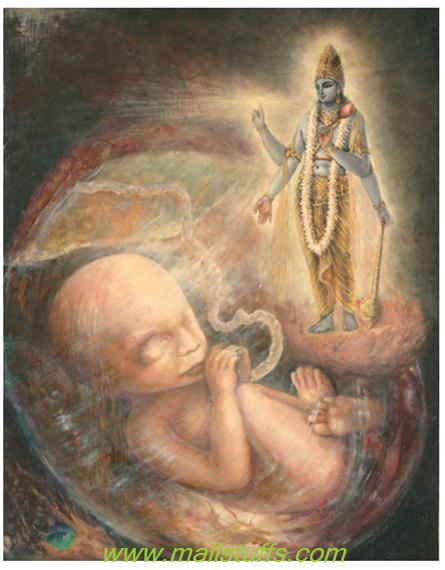
Spirit of supreme soul unites with Sonitum (ovum) and shukra(Sperm)
Symptoms of pregnancy
Symptoms of pregnancy is divided into two parts in ayurveda
• Sadyo garbha laksana (symptoms just after conception)
• Vyakta garbha laksana (symptoms after child body parts is formed inside embryo.)
Sadyo garbha laksana
weakness of thighs, Fatigue, thirst, quivering of vagina and retention of sukra (sperm) and sonitum (ovum).
Vyakta garbha laksana
Vomiting without cause, development of linea nigra, anorexia, heaviness of body especially legs, craving for pleasant aroma, salivation, Blackened lips and areola, tiredness, aversion for sour taste etc.
Components of embryo
Embryo or body features comprises of five elements of nature (Pancha maha bhutas)
Components from Prithvi (earth): Hair, Smell, Heaviness, Stability, Structure, Organ of smell perception, Bones.
Components from Agni (fire): Body temperature, Form, Organ of vision, Metabolism, Metabolic enzymes, Brightness or sharpness, Aura.
Components from Vayu (air): Organ of tactile sensation, Activity of body, Formation and transportation of dhatus, Sense of touch, Expiration.
Components from Jala (water): Coldness, Organ of taste perception, Taste, Softness, Moisture and body fluids, Fat, Unctuousness, Semen, Blood, Urine.
Senses from Akasa (space): Auditory system, Sense of sound, Division, Channels, Lightness, Orifices Minuteness.
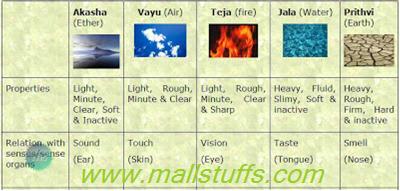
Body features from parents
Intensity of features inherited from parents depend upon the gender of the unborn child
Components from father: Beard and moustache, Nail, Hair, Bones, Tendons, Veins, Arteries, Semen, Teeth.
Components from mother: Muscles, Fat, Kidney, Pancreas, Spleen, Urinary bladder, Bone marrow, Skin, Liver, Stomach, Blood, Rectum, Intestines, Heart.
Components derived from Atma (soul): Knowledge about oneself, Happiness, sadness, emotions, Birth in specific species, Appearance.
Body features from nature (surroundings)
Components from Satva (mental faculty): Consciousness, Determination, Pride, Endeavour, Memory, Knowledge and Longevity.
Components from Satmya (habituation): life, living style of parents and sibling, Natural immunity, refined intelligence and function, Absence of idleness, Freedom from diseases, Longevity, Absence of greediness, Strength or energy.
Components derived from Rasa (food): Growth of body, Origin of body, Nourishment, Health, Formation of various body parts, Enthusiasm or zeal, Attachment to life, Energy or strength, Contentment, Complexion.
Fetal nourishment
Connected to maternal “rasavaha-nadi”, the umbilical cord provides the crux of mother’s diet to the child forming inside fetus. Child gets the vital nutrients for its sustenance from Upasneha (Moisture inside fetus) that runs obliquely along all his/her body parts. This continues since conception till the parts of child is fully formed inside embryo.
Phases of embryo formation
1st month: Embryo takes the shape of kalala(random or irregular form)
2nd month: Five elements of nature combines together to form the solid mass inside embryo. Sex of the child can be predicted at this stage. If the shape of the solid mass is elongated, baby is female, male if oval and hermaphrodite if the shape of the solid mass is round
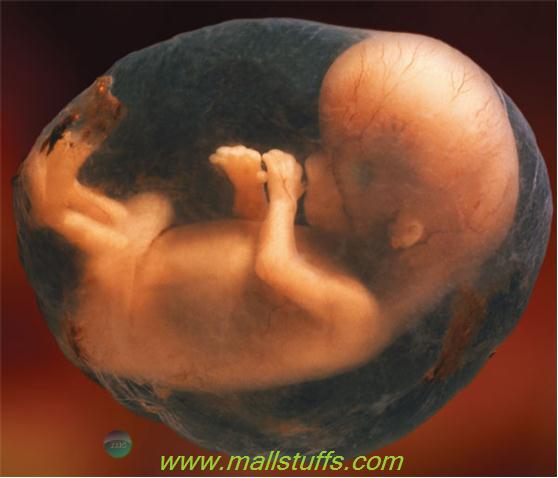
Oval mass means male child
3rd month: Sense organs and body parts of the child starts developing inside fetus.
4th month: Formation of different body parts like thorax, abdomen becomes stable and conspicuous. Heart is formed and hence, the Consciousness manifests inside the embryo. Character and behavior of the child is determined by the preference of taste and food the mother asks for during this period of pregnancy. If the preference and desires of mother is not met, the unborn child may undergo dwarfism, kyphosis, squint, or other congenital defects
5th month: Mind is developed and hence the increase in mental consciousness.
6th month: Mind becomes more developed. Hair, nails, veins and other similar organs develop in this month
7th month: All minor and major parts of the body becomes fully developed or almost conspicuous
8th month: Immaturity of fetus keeps the ojas(Vigor or energy) unstable. Ojas moves from fetus to mother and vice versa through fluid carrying channels. This movement of Ojas inside the fetus provides pain, itchiness or happiness to the mother alternately.
How to take care of pregnant woman
Cold liquid and sweet diet is recommended during the first five months of pregnancy. Ghee and rice mixed with goksura( Tribulus terrestris) must be given in the sixth month of pregnancy. During the seventh month, comsumption of Sarivana(Desmodium Gangetcium) medicated with ghee facilitate the proper development of embryo. Treatment of Anuvasana vasti (injection of oil inside the rectum through the anus for cleansing) is advised during eight and ninth month to ensure smooth delivery without any complications.

Treatment of Anuvasana vasti
If the child is born naturally, Clean the venix caseosa and Cut off the umbilical cord.
Apply Bala Taila(Child oil) on head and body of the born baby or herbs like vaca, jatamanasi after cleaning the oral cavity with ghee and rock salt
Ayurvedic treatise and medicines for pregnant woman
Some of the ayurvedic treatise advised during pregnancy are Vidaryadi Ghrita(herbal bath), Bala taila (Dhanvantara Tailam) regimens, Mani dharna (wearing gems), Application of Bala taila (Dhanvantara Tailam)
Various medicine prescribed during pregnancy are Brahma Rasayanam, Soubhagya sunthi, Bala Tailam Jirakadi Lehyam, Asvagandha (Withania somnifera), Vidarikanda (Ipomea digitata), Satavari (Asparagus racemosus), Draksa (Vitis vinefera).
Garbhini roga(Pregnancy diseases)
Kikkisa or Stri gravidram
Uterus enlargement resulting in linear contraction of abdominal skin, thighs and breast is called “kikkisa”.
Garbha pata and Garbha srava
Act of abortion of child in the first trimester is called Garbha srava and the unfortunate mnisscarraige in the second trimester is called Garbha pata
Causes for abortion/miscarriage
Miscarriage occurs due to various psychological and physical factors. Some of them are Gentetic defects, chromosomal defects, “Yoni dosa” (disease in repodcutive system), Lack of nutrition or bad karma. Other causes are fetal conditions like upasuska or upavistaka(Intra Uterine Growth Retardation)
Thus, I have ended my short preview on embryology from garbhopanishad. Now, let us go through the science of embryology from Charaka samhita
Introduction to Embryology in Charaka samhita
Ayurveda is the oldest medical science that elaborately describes the techniques of making various medicines from natural herbs and trees. Charaka samhita, a part of ancient ayurvedic science, was taught in ancient Vedic universities like Nalanda and Takshila University. One of the section of charaka samhita deals with embryology that describes various symptoms and signs of the mother at different phases of pregnancy. charaka samhita is an ocean of knowledge that served as a guideline for ancient ayurvedic doctors and is used for treatment even today by some modern doctors.
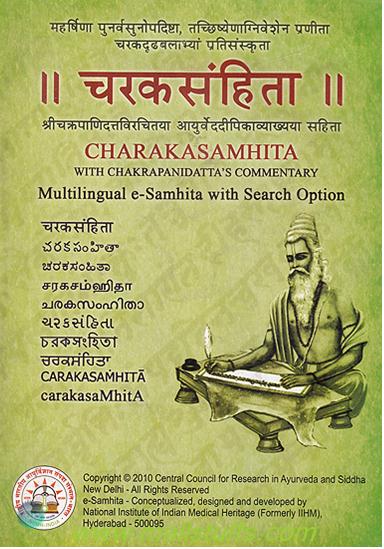
There are no evidences of advanced surgical instruments or advanced medical instruments belonging to Vedic period yet the detailed account of embryology including the facts that remains undiscovered by modern science is quite surprising
Verses on embryology with English translation and comparison to modern science
Below are some of the verses from charaka samhita along with the comparison with modern science.
Charaka Samhita, Vol 1, verse 1-3

Translation:
i) In the first month when sperm and ovum unite they turn into a seed-form and stick to the mucous membrane and start increasing in size. This seed divides from one into two, two to four; four to eight and so on till a round seed-form is formed.
ii) This seed-form has the capability to give rise to all kinds of tissues and organs.
iii) There are two types of seed-forms - the inner and the outer. The outer seed-forms are bigger than the inner seed-form. After sometime, a cavity is formed which is filled with fluid in between the two seed-forms. This fluid creates a gap between the two layers.
Comparison with modern science
1. Once the zygote has reached the two-cell stage, it undergoes a series of mitotic divisions, increasing the number of cells. Until the eight-cell stage they form a loosely arranged clump. Approximately 3 days after fertilization, cells of the compacted embryo divide again to form a 16-cell morula.
2. At a very early stage in development, the embryo proper acquires the form of a three-layered disc (three germ layers) called as embryonic disc. All the tissues of the body are derived from one or more of these layers.
3. About the time the morula enters the uterine cavity, fluid begins to penetrate through zona pellucida into the intercellular spaces of the inner cell mass. Gradually the intercellular spaces become confluent, and finally a single cavity, the blastocele forms.
<>
Charaka Samhita, Vol 1, verse 4 & 5

Translation:
iv) In the third month, all germinating parts appear.
v) a) At this time the head is quite large. The fingers are visible. b) The male and female sex organs are formed. c) The eyelids and lips are not separated.
Comparison with modern science
4. By the end of the embryonic period the main organ systems have been established, rendering the major features of the external body form recognizable by the end of the second month.
5. a) The head and upper limbs are still disproportionately large in the 3rd month.
b) By the 12th week, external genitalia develop to such a degree that sex of the fetus can be determined by external examination (Ultrasonography).
c) During the 3rd month eyelids meet and fuse.
Charaka Samhita, Vol 1, verse 6
Translation:
vi) Normally, after birth the hole in the middle flap of the heart chamber closes.
Comparison with modern science
6. Foramen ovale persists throughout the fetal life. After birth, foramen ovule is permanently obliterated by the fusion of the two flaps.
Charaka Samhita, Vol 1, verse 7 & 8

Translation:
vii) a) The heart of the foetus is attached to mother by fluid taking vessels. b) By the third month, heart appears and also starts pumping.
viii) a) By the third month, foetal heart increases in size and the foetal heart chambers are formed. b) But the foetal heart sound (FHS) can be heard per abdomen around the 4th month.
Comparison with modern science
7. a) Oxygenated blood from the placenta comes to the foetus through the umbilical vein, which joins the left branch of the portal vein.
b) During the 4th to 7th weeks the heart divides into a typical four-chambered structure.
8. a) During the 4th to 7th weeks the heart divides into a typical four-chambered structure.
b) With an ordinary stethoscope FHS can be detected between 18- 20 weeks.
Charaka Samhita, Vol 1, verse 9

Translation:
ix) The mucous membrane of the vagina gives a bluish tinge. And this sign appears by the beginning of the second month.
Comparison with modern science
9. Jacquemier's or Chadwick's sign: It is the dusky hue of the vestibule and anterior vaginal wall visible at about 8th week of pregnancy.
Charaka Samhita, Vol 1, verse 10

Translation:
x) a) In the fourth month, the shape of the body is almost formed. The pregnant women feel the foetal movements at times in this month. b) On head and at other sites instead of hair, fine hair-like structures can be seen.
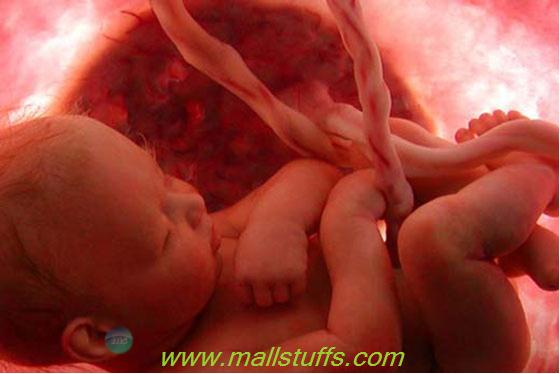
Comparison with modern science
10. a) Palpation of fetal parts can be made distinctly by 20th week. Active fetal movements can be felt at intervals by placing the hand over uterus as early as 20th week.
b) During the fourth month the covering of primary hair appears- lanugo.
Charaka Samhita, Vol 1, verse 11 & 12

Translation:
xi) a) In the fifth month due to the increase in the body mass and blood of the fetus, its movements can be clearly felt by pregnant women. b) In the middle or at the end of this month a physician can hear the FHS with the help of stethoscope. FHS is 120-140/minute. In males, it is generally <130/minute and in females >130/minute.
xii) First of all FHS is heard in the midline above the gluteal region. Later the site of FHS changes as per the presentation and lie of the fetus. This sound is heard after passing through the scapula and ribs of the fetus and therefore heard near the fetal shoulder.
Comparison with modern science
11. a) Active fetal movements can be felt at intervals by placing the hand over uterus as early as 20th week.
b) The heart rate varies from 140-160 per minute but gradually settles down to 120-140 per minute as the pregnancy advances.
12. The fetal heart sounds are best audible through the back (left scapular region) in vertex and breech presentation, where the convex portion of the back is in contact with the uterine wall. However, in face presentation, the heart sounds are heard through the fetal chest.
Charaka Samhita, Vol 1, verse 13 & 14

Translation:
xiii) Prior to the sixth month the fetal skin is wrinkled.
xiv) Eyebrows and eyelids are formed and the latter are still fused.
Comparison with modern science
13. During the 6th month the skin of the fetus is reddish and has a wrinkled appearance because of the lack of underlying connective tissue.
14. Eyelids and eyebrows are now well developed in the 6th month.
Charaka Samhita, Vol 1, verse 15-17

Translation:
xv) During the 7th month, the eyelids separate.
xvi) The testes descend near scrotum.
xvii) Baby born at the end of this month can survive only if provided with the special care. Majority of the babies born in this month do not survive.
Comparison with modern science
15. During the 7th month the eyelids themselves separate.
16. during the 7th month, the testes abruptly and rapidly passes through the inguinal canal and gains the scrotum.
17. A fetus born during the sixth or the beginning of the seventh month has great difficulty in surviving.
Charaka Samhita, Vol 1, verse 18

Translation:
xviii) (Eighth month) Fat accumulates beneath the skin and the wrinkles disappear. The fetus can survive if raised carefully.
Comparison with modern science
18. a) During the 7th month the skin loses its wrinkled appearance due to increased deposition of subcutaneous fat.
b) During the end of this month, the foetus is viable and may in fact be successfully raised if born prematurely.

Charaka Samhita, Vol 1, verse 19-20
